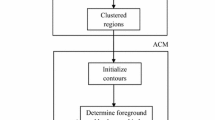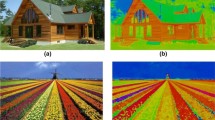Abstract
A novel neural network architecture suitable for image processing applications and comprising three interconnected fuzzy layers of neurons and devoid of any back-propagation algorithm for weight adjustment is proposed in this article. The fuzzy layers of neurons represent the fuzzy membership information of the image scene to be processed. One of the fuzzy layers of neurons acts as an input layer of the network. The two remaining layers viz. the intermediate layer and the output layer are counter-propagating fuzzy layers of neurons. These layers are meant for processing the input image information available from the input layer. The constituent neurons within each layer of the network architecture are fully connected to each other. The intermediate layer neurons are also connected to the corresponding neurons and to a set of neighbors in the input layer. The neurons at the intermediate layer and the output layer are also connected to each other and to the respective neighbors of the corresponding other layer following a neighborhood based connectivity. The proposed architecture uses fuzzy membership based weight assignment and subsequent updating procedure. Some fuzzy cardinality based image context sensitive information are used for deciding the thresholding capabilities of the network. The network self organizes the input image information by counter-propagation of the fuzzy network states between the intermediate and the output layers of the network. The attainment of stability of the fuzzy neighborhood hostility measures at the output layer of the network or the corresponding fuzzy entropy measures determine the convergence of the network operation. An application of the proposed architecture for the extraction of binary objects from various degrees of noisy backgrounds is demonstrated using a synthetic and a real life image.


















Similar content being viewed by others
References
Suzuki K, Horiba I, Sugie N (2000) Fast connected-component labeling based on sequential local operations in the course of forward-raster scan followed by backward-raster scan. In: Proceedings of 15th international conference on pattern recognition, vol 2, pp 434–437
Chang F, Chen C-J, Lu C-J (2004) A linear-time component-labeling algorithm using contour tracing technique. Comput Vis Image Underst 93(2):206–220
Gonzalez RC, Wintz P (1977) Digital image processing. Addison-Wesley, MA
Chen L-H, Chen J-R (2000) Object segmentation for video coding. In: Proceedings of 15th international conference on pattern recognition, vol 3, pp 383–386
Rosenfeld A, Kak AC (1982) Digital picture processing, vol 1. Academic, New York
Ekstrom MP (ed) (1984) Digital image processing techniques. Academic, New York
Meyer F, Beucher S (1990) Morphological Segmentation. J Vis Commun Image Represent 1(1):21–46
Hertz J, Krogh A, Palmer RG (1991) Introduction to the theory of neural computation. Addison-Wesley, Reading
Haykin S (1994) Neural networks: a comprehensive foundation. Macmillan College, New York
Lippmann RP (1987) An introduction to computing with neural nets. IEEE ASSP Magazine, 3–22
Forrest BM et al (1988) Neural network models. Parallel Comput 8:71–83
Pao YH (1989) Adaptive pattern recognition and neural networks. Addison-Wesley, New York
Chua LO, Yang L (1988) Cellular neural network: theory. IEEE Trans Circuits Syst 35:1257–1272
Chua LO, Yang L (1988) Cellular neural network: applications. IEEE Trans Circuits Syst 35:1273–1290
Bilbro GL, White M, Synder W (1988) Image segmentation with neurocomputers. In: Eckmiller R, Malsburg CVD (eds) Neural computers. Springer, New York
Abdallah MA, Samu TI, Grisson WA (1995) Automatic target identification using neural networks. SPIE Proc Intell Robots Comput Vis XIV 2588:556–565
Tang HW, Srinivasan V, Ong SH (1996) Invariant object recognition using a neural template classifier. Image Vis Comput 14(7):473–483
Kohonen T (1982) Self-organized formation of topologically correct feature maps. Biol Cybern 43:59–69
Kohonen T (1984) Self-organization and associative memory. Springer, London
Hopfield JJ (1984) Neurons with graded response have collective computational properties like those of two state neurons. Proc Nat Acad Sci USA 81:3088–3092
Nasrabadi MN, Li W (1991) Object recognition by a Hopfield neural network. IEEE Trans Syst Man Cybern 21(6):1523–1535
Kosko B (1988) Bidirectional associative memories. IEEE Trans Syst Man Cybern 18(1):49–60
Kosko B (1992) Neural networks and fuzzy systems: a dynamical systems approach to machine intelligence. Prentice-Hall, Englewood Cliffs
Ghosh A, Pal NR, Pal SK (1993) Self-organization for object extraction using multilayer neural network and fuzziness measures. IEEE Trans Fuzzy Syst 1(1):54–68
Duda RO, Hart PE (1973) Pattern classification and scene analysis. Wiley, New York
Tou JT, Gonzalez RC (1974) Pattern recognition principles. Addison-Wesley, Reading
Chiu WC, Hines EL, Forno C, Hunt R, Oldfield S (1990) Artificial neural networks for photogrammetric target processing. SPIE Proc Close Range Photogramm Meets Mach Vis 1395(2):794–801
Zamparelli M (1997) Genetically trained cellular neural networks. Neural Netw 10(6):1143–1151
Datta AK, Munshi S, Bhattacharyya S (2000) Object extraction in artificial retina using cellular neural network optimized by genetic algorithm with fuzziness measure. In: Proceedings of international conference on fiber optics and photonics, vol 2, pp 723–725
Zadeh LA (1965) Fuzzy Sets. Inform Control 8:338–353
Ross TJ, Ross T (1995) Fuzzy logic with engineering applications. McGraw Hill College Div.
Deluca A, Termini S (1972) A definition of non probabilistic entropy in the setting of fuzzy set theory. Inform Control 20:301–312
Bhattacharyya S, Dutta P, Maulik U (2006) A self supervised bi-directional neural network (BDSONN) architecture for object extraction guided by beta activation function and adaptive fuzzy context sensitive thresholding. Int J Intell Technol 1(4):345–365
Author information
Authors and Affiliations
Corresponding author
Rights and permissions
About this article
Cite this article
Bhattacharyya, S., Dutta, P. & Maulik, U. Binary object extraction using bi-directional self-organizing neural network (BDSONN) architecture with fuzzy context sensitive thresholding. Pattern Anal Applic 10, 345–360 (2007). https://doi.org/10.1007/s10044-007-0072-z
Received:
Accepted:
Published:
Issue Date:
DOI: https://doi.org/10.1007/s10044-007-0072-z




